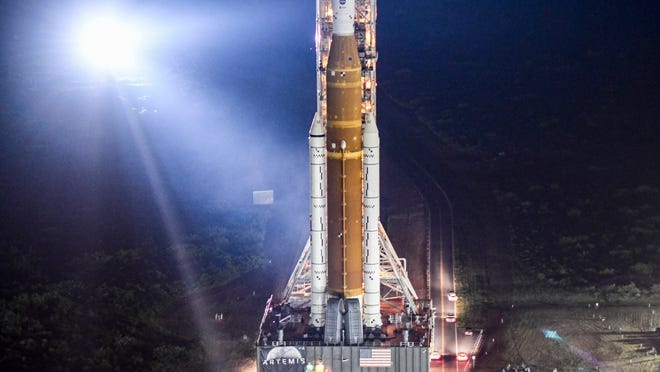NASA officials on Saturday said teams were planning to roll the 322-foot Space Launch System rocket for the Artemis I mission back to the Vehicle Assembly Building for repairs and recertifications, likely meaning a delay for the flight to most likely sometime in October.
A 2:17 p.m. ET Saturday, Sept. 3, the attempt was scrubbed primarily due to a large hydrogen leak. The issue was severe enough to call off all remaining launch opportunities in this Earth-to-moon window that closes after Tuesday, Sept. 6.
SLS uses liquid oxygen and liquid hydrogen as propellants. Saturday’s attempt saw the liquid oxygen tank 100% filled, but the hydrogen tank only hit about 10% before the scrub was called.
“This was not a manageable leak,” Artemis I Mission Manager Mike Sarafin told reporters Saturday.
Another roughly two-week launch window opens Sept. 19. While officials said that timeline is possible, it appears more likely that Artemis I won’t be ready to fly again until yet another two-week opportunity opens Oct. 17.
Graphics: After 50 years, US takes first step back to moon with launch of Artemis I
‘Space is the place’:NASA administrator touts Artemis I as the key to our future on Mars
Snoopy, Legos and ‘manikins’:Here’s what’s on board NASA’s Artemis I for its voyage to the moon
Why will it be a few weeks for Artemis I to launch?
Rolling back to the VAB for repairs, certifications, and preparations for another rollout to pad 39B would take “several weeks,” Sarafin said. But he cautioned that it was too early to rule out late September or early October.
One of the main reasons for a VAB rollback is the termination system, which destroys the rocket in case it veers off course or sees some other emergency issue. It needs to be re-certified – an operation that can only be done in the VAB – every 25 days, but officials said the Space Force might be willing to grant an extension. The military branch is in charge of public safety during launches, so it’s their call.
Officials also said the hydrogen leak could potentially be fixed at the pad.
But as it stands, the Space Force has not granted an extension and the leak, located in the lower portion of the 322-foot rocket, will most likely need to be fixed in the VAB. More details are expected early next week.
Officials will have more information early next week, said Associate Administrator for Exploration Systems Development James Free. NASA currently has an Oct. 3 SpaceX launch scheduled to send a crew to the International Space Station. Free said the overlap would need to be reconciled, and may put Artemis I’s launch to later in October.
“We do not launch until we think it’s right,” said the NASA administrator, former Sen. Bill Nelson.
Contributing: Mike Snider and Orlando Mayorquin, USA TODAY
Follow Jamie Groh on Twitter at @AlteredJamie.
What’s everyone talking about?: Sign up for our trending newsletter to get the latest news of the day


